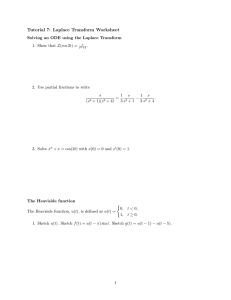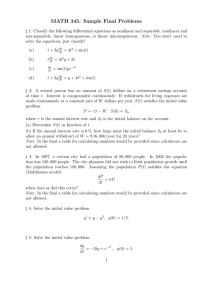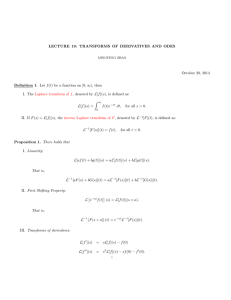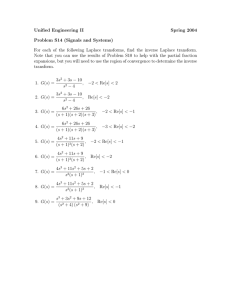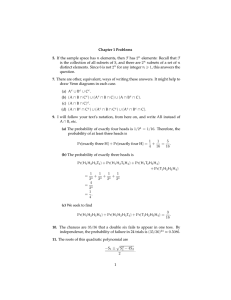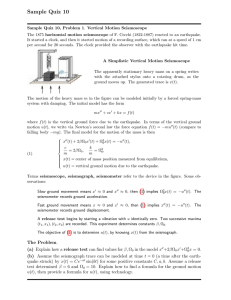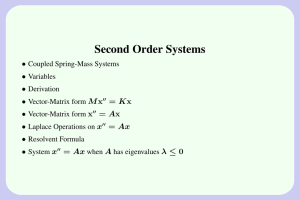Math 2250 Lab 12 (Sample) Name:
advertisement
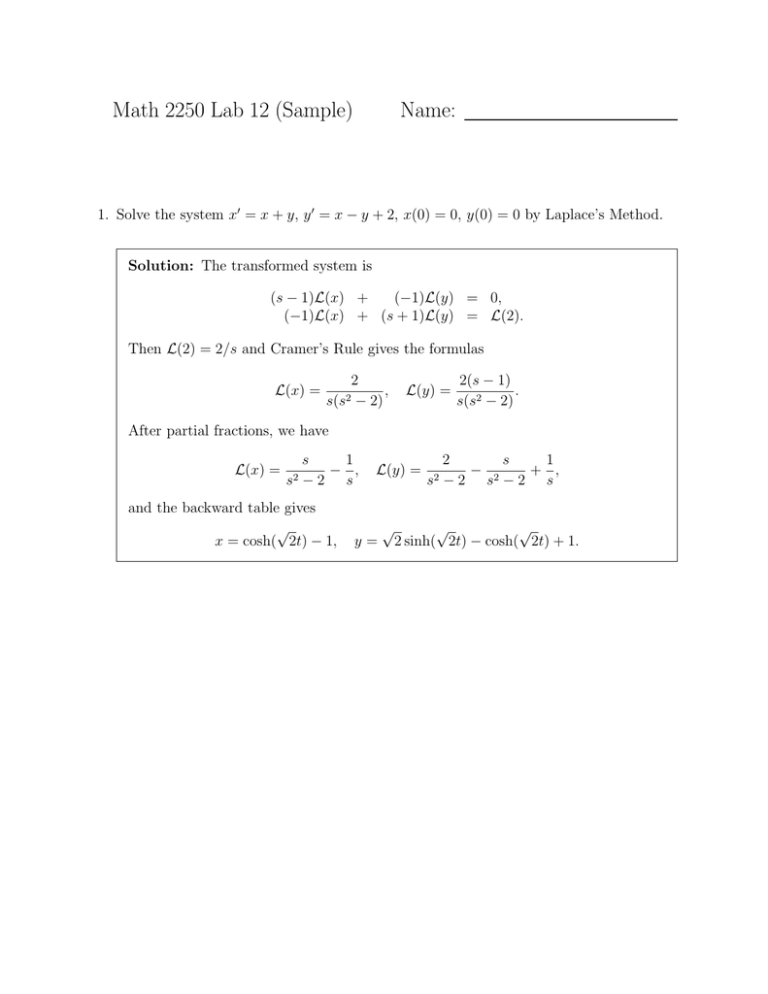
Math 2250 Lab 12 (Sample)
Name:
1. Solve the system x0 = x + y, y 0 = x − y + 2, x(0) = 0, y(0) = 0 by Laplace’s Method.
Solution: The transformed system is
(s − 1)L(x) +
(−1)L(y) = 0,
(−1)L(x) + (s + 1)L(y) = L(2).
Then L(2) = 2/s and Cramer’s Rule gives the formulas
L(x) =
2
,
− 2)
s(s2
L(y) =
2(s − 1)
.
s(s2 − 2)
After partial fractions, we have
L(x) =
s2
s
1
− ,
−2 s
and the backward table gives
√
x = cosh( 2t) − 1,
L(y) =
y=
s2
2
s
1
− 2
+ ,
−2 s −2 s
√
√
√
2 sinh( 2t) − cosh( 2t) + 1.
2. find the following series:
∞
X
(e−s )k ,
k=0
for s > 0.
Solution: Applying the formula for geometric series
∞
X
k=0
Then we have
∞
X
(e−s )k =
k=0
rk =
1
, with r = e−s .
1−r
1
.
1 − e−s
Note that it is legitimate to use the geometric series because s > 0, and hence
|e−s | < 1.
Page 2
3. Suppose a certain spring-mass system with no damping satisfies the initial value problem
x00 (t) + 9x(t) = f (t)
x(0) = 0, x0 (0) = 0
where
0≤t<4
0
(t − 4)/4 4 ≤ t ≤ 8
f (t) =
1
t>8
(a) Find the general form of the solution in the following cases.
Case t < 4.
Solution: For t < 4, x(t) = c1 cos(3t) + c2 sin(3t). The initial conditions
imply x(t) = 0.
Case t > 8.
Solution: For t > 8, x(t) = c1 cos(3t)+c2 sin(3t)+ 19 where 19 is a particular
solution of the nonhomogeneous equation and the other two terms compose
the complementary or homogeneous solution. Thus, this solution is a simple
harmonic oscillator about x = 91 .
(b) Show the details required to rewrite f (t) in terms of the unit step functions u(t − 4)
and u(t − 8), as the expression
f (t) =
u(t − 4)(t − 4) − u(t − 8)(t − 8)
4
(c) Solve the initial value problem using Laplace’s method.
Page 3
Solution:
u(t − 4)(t − 4) − u(t − 8)(t − 8)
}
4
[u(t − 8)](t − 8)
[u(t − 4)](t − 4)
} − L{
}
⇒ L{x00 (t)} + 9L{x(t)} = L{
4
4
e−4s − e−8s
⇒ s2 L{x(t)} − x0 (0) − sx(0) + 9L{x(t)} =
4s2
−4s
e − e−8s
⇒ s2 X(s) + 9X(s) =
4s2
−4s
e − e−8s
2
⇒ (s + 9)X(s) =
4s2
−4s
e − e−8s
⇒ X(s) = 2
(s + 9)(4s2 )
L{x00 (t)} + L{9x(t)} = L{
Let H(s) =
1
.
s2 (s2 +9)
The partial fraction expansion of H(s) is
H(s) =
1/9
1/9
− 2
2
s
s +9
Thus, the inverse Laplace transform of H(s) is
1
1
sin(3t)
h(t) = t −
9
27
and the solution of the initial value problem is
x(t) =
u(t − 4)h(t − 4) − u(t − 8)h(t − 8)
4
Page 4

